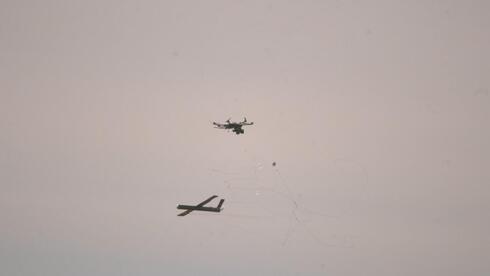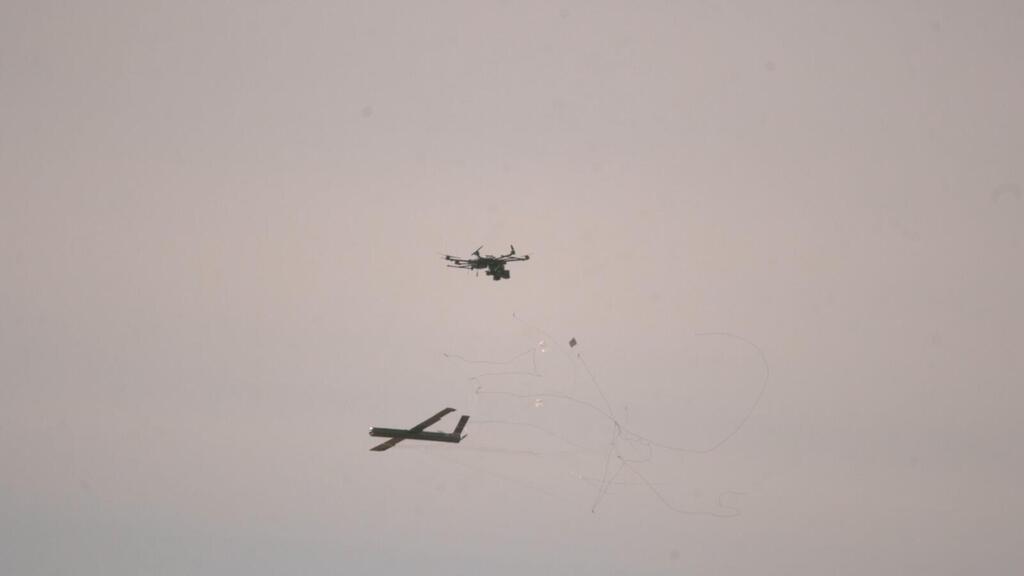
Israeli defense industry targets new threats with cutting-edge drone defense systems
A comprehensive showcase of defensive technologies provides hope for stronger national security against drone incursions.
The defense establishment is making progress in the development of interception systems for explosive drones, which have posed a significant challenge to the IDF's air defense system since the outbreak of the war. These drones have forced millions of Israeli residents into protected spaces for extended periods. This development comes after nine defense companies and startups presented on Tuesday about 20 technological solutions at a simulated testing field in the Negev. The solutions are designed to offer effective protection against this growing threat.
Among the companies that participated in the test, Israel Aerospace Industries presented an integrated solution that includes a range of sensors and distributed interception systems, such as electric missiles and a 30 mm cannon, which can neutralize drones at various distances. Aerobotics showcased a system based on a reusable interceptor, while Rafael presented the remotely controlled Mini-Typhoon. Elbit Systems demonstrated drones capable of intercepting and shooting down other drones. Other participants included Robotican, Xtend, General Robotics, Smart-Shooter, and Tamar. This is the second time since October that the Ministry of Defense has invited defense industries to showcase new developments and capabilities in drone defense, with another round of testing expected soon.
According to security sources, although the drones launched at Israel by Iran and its proxies—mainly Hezbollah and the Houthis—carry relatively small warheads, they pose a significant risk due to their precision, which allows them to hit sensitive targets. This has necessitated a reliable and robust defensive response. For example, a drone launched by Hezbollah last October bypassed all Israeli defense systems, reached Prime Minister Benjamin Netanyahu’s private residence in Caesarea, and exploded on his bedroom window.
The Negev test focused only on the interception capabilities of the systems presented by the defense industries, with hundreds of target drones launched at them in various flight and attack scenarios. However, the test did not assess the detection and identification capabilities of drones, nor did it evaluate the ability to neutralize them using "soft defense" measures, such as jammers linked to electronic warfare systems.
Security sources indicated that the development of drone detection and identification systems is proceeding in parallel with the development of interception technologies. The response to the threat will be phased, relying on multiple complementary solutions. Continuous learning will take place as enemy tactics evolve. "We are dealing with targets that create very low radar signatures and exploit the topography for flight. We are preparing for large quantities of such tools," said a senior Defense Ministry official. "The response we are aiming for is to protect borders, maneuvering forces, vital assets, and the entire public across the country. This is a precise threat, and therefore we are striving for a tight, effective response that will improve over time."
Danny Gold, head of the Directorate of Defense Research and Development,at the Ministry of Defense, stated, "We are committed to completing a broad and reasonably cost-effective defensive response, just as we did with missile and rocket interception systems."
A source in the Ministry of Defense reported that significant improvements have been made in the detection and identification of unmanned aerial vehicles (UAVs) in recent months, which is reflected in the ability to track these threats. "This is a dramatic improvement that is also being reflected in force-building plans for this issue," the source said. In response to a question from Calcalist, the source noted that there has also been progress in addressing the threat of anti-tank missiles (ATMs) launched from southern Lebanon toward Israeli towns along the border, with no warning given, similar to rocket fire. "We are working on a response to this threat through ongoing field experiments," the source added.
Meanwhile, the defense establishment is reporting a significant improvement in identifying and detecting paragliders, such as those used by terrorists who left Gaza on October 7th to target kibbutzim along the perimeter. The war revealed several failures in the air defense system and the defense establishment's ability to respond to the UAV and drone threat. This is despite the fact that such threats have been recognized for years, especially in the context of the Russia-Ukraine war. Israeli complacency came at a cost, as the country struggled to provide an adequate response with systems like Iron Dome, David's Sling, and Arrow missiles, which were effective against rockets and missiles.
Some defense companies have claimed that although they developed effective systems to neutralize UAVs, the defense establishment has not equipped itself with these solutions. In response, a defense source said, "We have examined every possible solution. Our reference scenario is dramatic and difficult, and not all solutions work within the context we define. Not all solutions are effective in an environment with GPS jamming. Not every solution in a particular arena is relevant to us."















